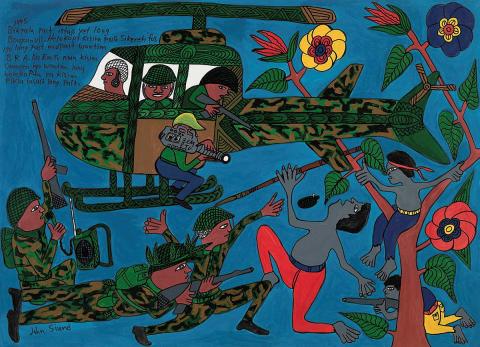John Siune: Bikpela pait istap yet long Bougainvil...
John Siune was born in 1965 in Kapank, a village in Papua New Guinea's Highlands. In 1982 he moved to Port Moresby, where he was employed and trained by a glass company as a picture framer. It is said that it was here that he saw the work of Mathias Kauage, a senior artist from his region (also represented in the QAGOMA Collection), and was introduced to the idea of art as an object with commercial value.
Siune began painting in 1989. His work emerged from an artistic trend that curator and researcher Susan Cochrane has identified as 'the new Highlands art movement'.1 The visual vocabulary and style of the new Highlands art was first developed in the 1970s by two influential artists from Papua New Guinea's Highlands, Mathias Kauage and Jakupa Ako. Kauage and Ako's works are characterised by highly decorated figures defined by a black outline and painted in rich colours. The figures — whether they represent animals, people or plants — are treated in a stylised manner without anatomical detail. This approach reflects the aesthetics of traditional New Guinea design where images are normally treated as symbolic iconography, rather than realistic representations.
The figures are set in a two-dimensional space devoid of perspective devices. Their themes and narratives are drawn from the artists' natural and cultural environment and often incorporate modern technology, such as helicopters and aeroplanes. Younger artists, including John Siune, Oscar Towa, Apa Hugo and Gigs Wena have since made their own contribution to the development of new Highlands art. Susan Cochrane comments that in Siune's work
large acrylic narrative works have portrayed the eruption of the Rabaul volcano, the conflict in Bougainville, pollution caused by mining and the rascal problem (urban violence and thieving) which plagues Port Moresby. There is often an element of good-natured humour or more savage wit in his paintings, a feature he shares with other Highlands artists.2
Siune introduced art themes of social critique: in 1991 in Port Moresby he exhibited a painting of the Bougainville war that depicted a television camera man filming hostilities. The painting marked a significant turn in Siune's art, which has since engaged with contemporary and often controversial issues relating to Papua New Guinean society.
Siune has painted the theme of the Bougainville war on numerous occasions. The work The big fight in Bougainville is based on the painting with the same theme shown in 1991. The inscription in Pidgin describes the scene and translates as follows:
The big fight in Bougainville. A helicopter of the PNG Security Forces is fighting the BRA [Bougainville Revolutionary Army] and an EM TV camera man is filming the fight.
Endnotes
- Susan Cochrane, Contemporary art in Papua New Guinea, Craftsman House, Roseville, 1997, p.55.
- Cochrane, p.56.
